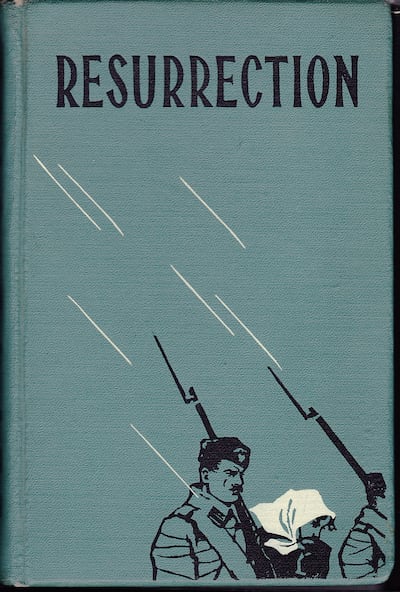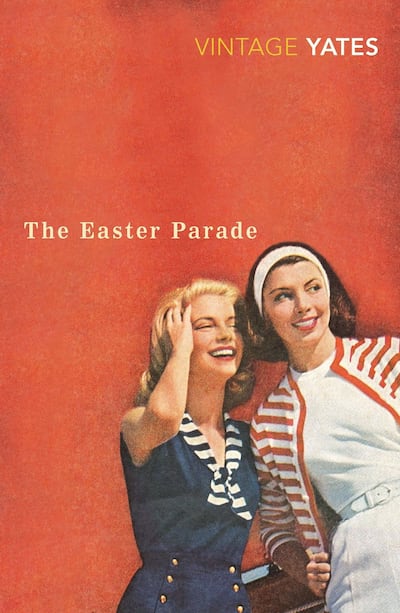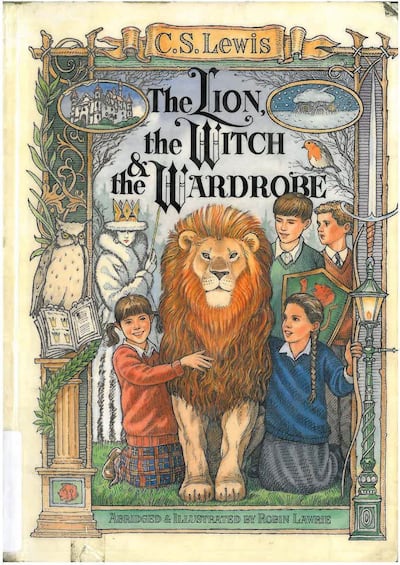With the wealth of inspiration that the homeliness of Christmas offers, Easter can appear to be literature’s second-string festival. As a festival, Easter offers real drama. It begins with triumph, goes through betrayal, despair, suffering and for believer’s it culminates in great triumph. For a novelist it offers a great symbolic journey, which as well as being the journey of a great man is the journey of humanity. As well as the religious symbolism of Easter the idea of becoming new is very potent, the idea of being born again and beginning afresh.
The word Easter comes from a Germanic word that is cognate with "east", and therefore with dawn, pointing to the spirit of new beginnings which Easter represents. Benjamin Disraeli coined the term for celebrating Easter, so however you're Eastering this weekend there are no shortage of literary works inspired by Easter to keep you company.

The Sound and the Fury by William Faulkner Faulkner took the title for this novel from the Macbeth speech where Macbeth laments the futility of life being a " tale, told by an idiot, full of sound and fury, signifying nothing".
It opens inside the mind of the “idiot,”Benjy Compson, a 33-year-old man who has the mind of a small child. More than any other modern masterpiece Easter is pivotal to the novel’s architecture and plot. Three of the four parts of Faulkner’s magnum opus are set on the Easter weekend of 1928, with the final part occurring on Easter Sunday. In the novel, several characters experience parallels with Christ’s death and/or his resurrection. Friday’s narration is by Jason, the cruel, sadistic male heir of the Compsons whose malevolence is in stark contrast to Christ’s forgiveness and love. Holy Saturday marks its narrator Benjy’s birthday as he turns 33; Jesus Christ died at age 33. Benjy may be seen as a Christ figure, cast aside as an idiot and made impotent by modern society. The deaths of Quentin and Mr Compson, the loss of Caddy’s virginity, and the deterioration of the Compson family may all be viewed through the lens of Christ’s death and resurrection.
A segment of Sunday’s narration, often known as “Dilsey’s part”, although not narrated by her, is set in a church of African Americans rocked by a moving sermon about the resurrection. This segment crystallises the goodness of Dilsey, who reflects Christian principles demonstrated by Jesus: strength, courage, and love. In the end, readers must decide for themselves if there is any redemption for the Compson family.

Resurrection by Tolstoy This is Tolstoy's last novel and perhaps his most controversial. Published in 1899 it is a scathing indictment of injustice, corruption and hypocrisy at all levels of Russian society. The story of Prince Dmititi Nekhlyudov's journey to redeem a past guilt, Tolstoy's storytelling genius bring to life this unjust world.
Tolstoy never did anything more delightfully infectious in fiction than the scene of the Easter service in the village church, where the young hero and heroine, after the traditional Russian greeting "Christ is risen", exchange kisses with the carefree rapture of mingled religious exaltation and dawning affinity for each other. "Everything seemed festive, solemn, bright, and beautiful: the priest in his silver cloth vestments with gold crosses; the deacon, the clerk and chanter in their silver and gold surplices; the amateur choristers in their best clothes, with their well-oiled hair; the merry tunes of the holiday hymns that sounded like dance music; and the continual blessing of the people by the priests, who held candles decorated with flowers, and repeated the cry of "Christ is risen!" "Christ is risen!" All was beautiful; but, above all, Katusha, in her white dress, blue sash, and the red bow on her black head, her eyes beaming with rapture."

Easter Parade by Richard Yates Joan Didion considers this "Yates's best novel", even better than Revolutionary Road, which was made into a film by Sam Mendes starring Kate Winslet and with Leonardo DiCaprio. The Easter in Yates's novel is not one that is a portend to renewal and rebirth, it is an Easter that is a watershed moment in the lives of two girls Sarah and Emily. Sarah dresses up in "an expensive dress of heavy silk" and a " broad-brimmed hat of closely woven straw" to take part in New York's Easter Parade . As she is driven uptown by her handsome fiancé, her younger sister Emily watches on giddy with the promise life holds. The New York Times photographed the couple and the camera "had caught Sarah and Tony smiling at each other like the very soul of romance in the April sunshine, with massed trees and a high corner of the Plaza hotel just visible behind them" . The novel ends during a Springtime decades later, the story of the girl's lives and loves delivered in exquisite prose by this master storyteller. Yates has an unflinching eye for the human capacity for self-delusion and for excavating a bleak beauty from life's tragedies. Yates has been described as the Flaubert of the Eisenhower years; he peeled away the veneer of postwar plenty and saw the empty chasm beneath.
Unkept Good Fridays by Thomas Hardy Innovative in his use of stanza and voice, Hardy's poetry, like his fiction, is characterised by a pervasive fatalism. In the words of biographer Claire Tomalin, the poems illuminate "the contradictions always present in Hardy, between the vulnerable, doomstruck man and the serene inhabitant of the natural world". Hardy's Easter poem eschews the traditional religious Easter poems in this tribute to the "unpenned.. nameless Christs", "men whom rulers slew/ For their goodwill." This poem commemorates victims of torture and oppression who have no Good Fridays to remind the world of their suffering and death.
East Coker by TS Eliot The Easter theme of this, the second of Eliot's Four Quartets, is especially prevalent in the fourth section, a short lyric which casts Christ as a "wounded surgeon" – wounded because of the crucifixion, but a "surgeon" who carries the cure for all of humanity's ills. Eliot wrote East Coker in 1940, against the background of the second World War and the Blitz.

Lead Us Into Temptation by Breandán Ó hEithir Set during the Easter weekend of 1949(the date of the declaration of the Irish Republic )in the university town of Baile an Chaisil, a thinly disguised Galway, the novel immerses the reader into the bawdy world of Martin Melody, a pub-crawling university student and his student side kicks. The novel was published in 1976 as Gaeilge as Lig Sinn i gCathú, a rebellious challenge to the pious Lord's Prayer. Breandan O hEithir's fictoir will strike a chord with any one who lived the student life with his depictions of odious landladies, crackpot academics and clergymen. After a particularly indulgent session on holy Thursday night Martin and his dig's room mate Billy are awoken by the landlady Mrs Anderson, who had already been to morning devotions, the stations of the cross, had visited the cemetery and a session of scandalmongering in her sister's house. She's hammering on the door screaming: "In the name of God, boys, are you trying to bring the curse of the Almighty down on my house? For God's sake, get up quick! It's gone one o; clock. Get up and show some respect for the Passion, the Divine Thirst and the Crucifixion." This reader could well imagine the divine thirst that Martin and Billy were experiencing and could empathise with the misery they endured on that long Good Friday.

The Lion the Witch and the Wardrobe by CS Lewis CS Lewis's The Lion, the Witch, and the Wardrobe is the opening novel of the Chronicles of Narnia series and is widely regarded as its highlight. Lewis felt that some of the religious stories of his childhood lacked the creative spark to invite an "imaginative welcome" to the Christian faith. Lewis wanted to rewrite the religious stories of his boyhood and imbue them with a fantastical, magical feel. Religious symbolism plays a major role in the Chronicles of Narnia.One of the best examples of this symbolism is Aslan, the noble lion of Narnia. Just about everyone agrees that he's the stand-out character of the Chronicles of Narnia and probably Lewis's greatest literary creation. Aslan is a literary Christ figure who plays a pivotal role in the story of Narnia, just as Jesus Christ is central to the Christian faith.
Lewis explained in a letter to his friend Arthur Greeves in October 1931, that he set out his story of Aslan as a retelling of the "actual incarnation, crucifixion, and resurrection". The future of this story is assured as it opens up some of the deepest questions of life and points to that the special beauty and wonder at the heart of the universe.
Lewis does not tell us what Jesus Christ is like; he shows us what Aslan is like, and allows us to take things from there by ourselves.
"Let us suppose that there were a land like Narnia, and that the Son of God, as he became a Man in our world, became a Lion there, and then imagine what would happen," he told a school class in Maryland in a letter in 1954.
For Lewis, one of Aslan’s chief roles is to enable people to discover the truth about themselves.











